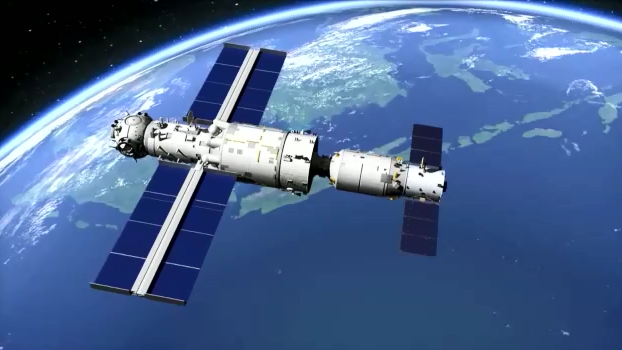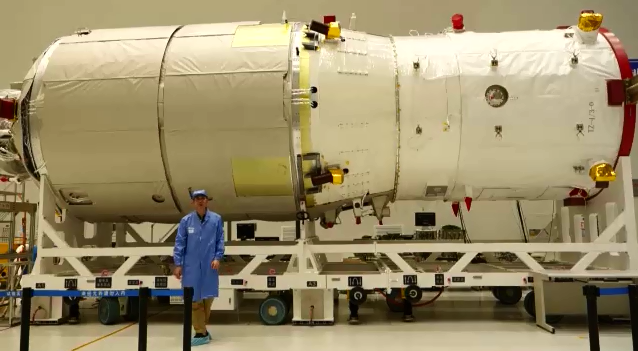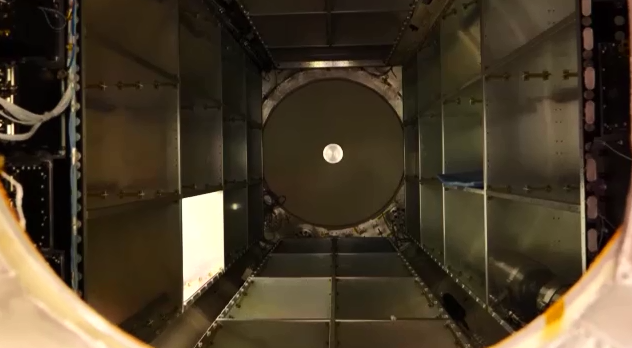
A model showing China's Tianzhou-2 cargo spacecraft docks with its space station core module Tianhe. /CMG
A model showing China's Tianzhou-2 cargo spacecraft docks with its space station core module Tianhe. /CMG
China's Tianzhou-2 cargo spacecraft, the "delivery guy" for China's space station, docked with the newly-launched Tianhe core module early Sunday morning, eight hours after its launch from the Wenchang Spacecraft Launch Site.
The Tianzhou-2 cargo ship has a length of 10.6 meters and a width of 14.9 meters when its two solar arrays are fully deployed. With a maximum takeoff weight of 13.5 tonnes and a payload capacity of 6.9 tonnes, it is the world's largest cargo spacecraft in service.
It is composed of two segments, a cargo compartment with a diameter of 3.35 meters and a propulsion compartment with a diameter of 2.8 meters. Supplies are loaded inside the pressurized cargo section and propellant in the propulsion section.

The Tianzhou-2 cargo freighter is composed of two segments, a cargo compartment (L) with a diameter of 3.35 meters and a propulsion compartment (R) with a diameter of 2.8 meters. /CMG
The Tianzhou-2 cargo freighter is composed of two segments, a cargo compartment (L) with a diameter of 3.35 meters and a propulsion compartment (R) with a diameter of 2.8 meters. /CMG
The cargo compartment has a room of around 40 cubic meters, with 208 lockers to store different categories of goods.
Various supplies for the astronauts and space experimental gear are stored inside the lockers. There are also two spacesuits for extra-vehicular activities, each weighing more than 100 kilograms.
It also delivers space food, including many traditional Chinese dishes. From staple to non-staple food, meat to vegetables, the menu design is of high quality and appetizing for astronauts. Famous stir-fried Chinese dishes like shredded pork with garlic sauce and Kung Pao chicken are both on the menu.

The cargo compartment of Tianzhou-2 has a room of around 40 cubic meters, with 208 lockers to store different categories of goods. /CMG
The cargo compartment of Tianzhou-2 has a room of around 40 cubic meters, with 208 lockers to store different categories of goods. /CMG
In the past, astronauts often had difficulties finding the things they wanted quickly because of the large quantity and variety of goods onboard. Tianzhou-2 has solved the problem by using an intelligent cargo management system. There is a QR code on each locker, and astronauts just need to scan the QR code with their phones to find out what's inside every locker.
Except for delivering daily supplies and science equipment for the astronauts, another critical task for Tianzhou-2 is to replenish the propellant for the Tianhe core module.
There are eight storage tanks in the propulsion compartment, with 3.5 tonnes of propellant loaded, 2.5 tonnes of which is to refuel the Tianhe core module. The remainder is for its own operational needs.
Now docked, Tianzhou-2 will conduct an automatic transfer of propellant to the Tianhe module. It will remain docked to the station module to support the upcoming manned Shenzhou-12 mission in June.
With a power supply capacity of no less than 2,700 watts, the cargo craft will operate in orbit for one year.
A powerful propulsion system
A powerful propulsion system is a must for such a big spacecraft as Tianzhou-2 to conduct maneuvers and dock with the Tianhe core module.
Tianzhou-2 is equipped with 36 engines, including four enormous power orbital control engines used for maneuvers like changing orbit and some small power engines for fine-tuning its position.
Four 'eyes' to ensure safety
Tianzhou-2 has four monitoring cameras for its proper and safe operation. One is at the front to watch and record its docking process with the Tianhe core module. Another is at the bottom of its body to watch the unfolding process of its solar arrays. There are also two cameras inside its cargo compartment, through which staff on the ground can check the amount of goods that have been used and see astronauts' activities.

